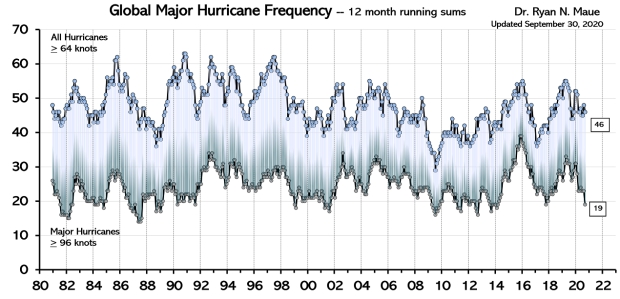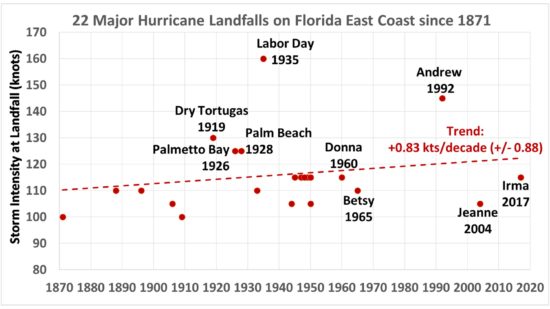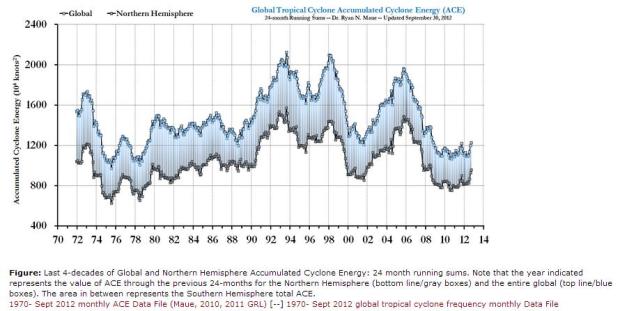The leftish press and Hollywood climate experts have been claiming that the recent rash of dangerous hurricanes is due to global warming. Dr. Roy Spencer, U.S. Science Team leader for the Advanced Microwave Scanning Radiometer flying on NASA’s Aqua satellite, takes exception to these claims in a short blog post and in a new E-bookavailable from Amazon for $2.99. The E-book is about 11,000 words long and contains 17 illustrations. I recommend you read it.
In the book, Spencer explains the origin of hurricanes and gives a history of U.S. hurricanes from colonial times to present time, including comments on hurricanes Harvey and Irma.
Spencer notes that geological studies of sediments in coastal lakes in Texas and Florida show that “catastrophic hurricane strikes were more frequent 1,000 to 2,000 years ago than in the most recent 1,000 years.” Hurricanes making landfall in Florida show a downward trend in both number and intensity (that trend includes hurricane Irma). Spencer says that hurricanes in tropical Atlantic, Caribbean, and Gulf of Mexico are not limited by sea surface temperatures.
He also notes that “ two major hurricane strikes endured by the Massachusetts Bay Colony, in 1635 and in 1675, have yet to be rivaled in more modern times.”
“…Most Atlantic hurricanes can be traced back to African easterly waves [of low wind shear]. These waves draw their energy from the temperature contrast between the hot air over the Sahara Desert and the cooler air over the Sahel, and as they leave the west coast of Africa they ‘kick start’ the organization of rain shower activity over the tropical eastern Atlantic Ocean.”
You will have to read the E-book to delve more deeply into the mechanics of hurricanes. Here is an excerpt:
If you were to go up inside the eye at the altitude where jets fly, you would find the air temperature there is 10 or 20 deg. F warmer than normal for that altitude. This warmth is caused by air being forced to sink in response to rising air in the showers and thunderstorms surrounding the eye. This ‘subsidence warming’ is a universal feature of all precipitation systems, but only in hurricanes is it highly concentrated into one relatively small area. All of the warm rising air in billowing rain clouds must be exactly matched by sinking air elsewhere, and in the case of hurricanes, that sinking air is most concentrated and intense in the eye of the storm. For more common rain systems, the warming is much weaker as it is spread over huge areas hundreds or even thousands of miles in diameter. Only a few miles away from the eye is the heavily raining eyewall of the hurricane; this is where the strongest surface winds occur.
Spencer also has a chapter on “The Effect of Sea Level Rise on Hurricane Storm Surge” in which he shows that sea level rise has been mostly if not entirely natural, with no convincing evidence that it has accelerated from human-caused global warming.
Separate from Spencer’s data, Dr. Chris Landsea of NOAA Hurricane Research Division presents at table of Atlantic hurricanes beginning from 1851. You will see that there is no sign of influence by global warming. Landsea has this caveat about the data: “The Atlantic hurricane database (or HURDAT) extends back to 1851. However, because tropical storms and hurricanes spend much of their lifetime over the open ocean – some never hitting land – many systems were “missed” during the late 19th and early 20th Centuries (Vecchi and Knutson 2008). Starting in 1944, systematic aircraft reconnaissance was commenced for monitoring both tropical cyclones and disturbances that had the potential to develop into tropical storms and hurricanes. This did provide much improved monitoring, but still about half of the Atlantic basin was not covered (Sheets 1990). Beginning in 1966, daily satellite imagery became available at the National Hurricane Center, and thus statistics from this time forward are most complete (McAdie et al. 2009).” See data
Back in 1999, Landsea et al. published a paper which found “that multidecadal variability is more characteristic of the region. Various environmental factors including Caribbean sea level pressures and 200mb zonal winds, the stratospheric Quasi-Biennial Oscillation, the El Niño-Southern Oscillation, African West Sahel rainfall and Atlantic sea surface temperatures … show significant, concurrent relationships to the frequency, intensity and duration of Atlantic hurricanes.” (Source)
Dr. Neil Frank, former Director National Hurricane Center:
“Over the past several weeks numerous articles suggest Harvey and Irma were the result of global warming. The concept is a warmer earth will generate stronger and wetter hurricanes. A number of people have said Irma was the most intense hurricane in the history of the Atlantic while Harvey was the wettest and both were good examples of what we can expect in the future because of global warming. What does a fact check reveal about these two hurricanes?”
Frank shows that neither of the above contentions is true, read more.
See also:
Houston’s long history of flooding
Evidence that CO2 emissions do not intensify the greenhouse effect
An examination of the relationship between temperature and carbon dioxide
A Simple Question for Climate Alarmists









